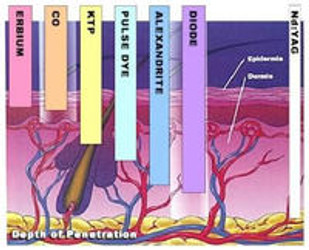WHAT TYPES OF LASER HAIR REMOVAL TECHNOLOGY EXIST?
Posted by Asim Jalali on 6th Apr 2015

There are many different types of laser hair removal technology used by equipment manufacturers. Each type of laser technology is suitable for particular types of people. The following is a brief insight into the different types of laser hair removal systems available along with the pros and cons of each.
Alexandrite Laser
The long-pulse alexandrite laser has the ability to penetrate deeply into the dermis. The resultant heat build up in the hair shafts disables the hair follicles in the active growth phase which enables it to achieve effective laser hair removal.
Specifications
- Wavelength: 755
- Pulse width: 2-20
- Fluence: 10-40
- Spot size: 5-10
- Repetition rate: 1-5
Devices available
- Apogee-40
- EpiTouch Alex
- GentleLASE
Disadvantages
- Hair removal is short term.
- Occurrence of side effects in 2% of dark coloured patients.
Diode Laser
Diode lasers are very effective. Laser production is triggered by small diodes or semiconductors that are arranged together to produce light beam. The diode laser has a longer wavelength than other types of lasers, which may improve treatment results on darker skin types.
Specifications
- Wavelength: 800-810
- Pulse width: 5-30
- Fluence: 10-40
- Spot size: 9
- Repetition rate: 1
Devices available
Several 800-nm diode lasers have been granted FDA approval:
- Apex-800 Iriderm
- LaserLite
- SLP100
- EpiStar
- MeDioStar diode laser
- Do-it-yourself Rio LAHR laser hair removal system has been recently introduced and utilises 808-nm laser technology.
Advantages
- Longer wavelength results in better performance on darker skin types.
- Deep penetration & targeting of deep hair follicles.
Disadvantages
Diode lasers have been linked with the onset of urticaria in some patients. It’s a severe allergic skin reaction similar to hives and can be managed by anti-allergic drug therapy.
Q-Switched Nd: YAG Laser
This laser has the ability to deliver two different wave lengths of light. The first is an infrared light used for deep penetration. This wavelength is used to get to deeper into hair follicles. The other wavelength, a green light, is used for treating hair follicles closer to the surface of the skin. In both cases, the Q-switching device emits rapid bursts of laser light to the area being treated.
Specifications
- Wavelength: 1064
- Pulse width: 10-50
- Fluence: 20-100
- Spot size: 3-5
- Repetition rate: Up to 10 Hz
Advantages
- Provides surface cooling & epidermal protection due to surface cooling and longer pulse duration of these lasers.
- Long term studies show that these laser systems can achieve a significant delay in hair regrowth.
- Nd: YAG 1064 nm system may be best for darkly pigmented people.
Disadvantages
- The waxing and carbon lotion application is cumbersome.
- No clinical data to support that added benefits are achieved when pre-treatment waxing or carbon suspension is used.
- Not proven effective for long-term results.
Devices available
- Carbon suspension Q-switched lasers SoftLight
- Q-switched Nd: YAG laser MedLite IV
- Long-pulsed Nd: YAG lasers
Ruby Laser
This laser emits a red coloured beam which targets the melanin inside hair shafts and adjoining hair follicles. Due to their specific melanin targeting features these are best suited for individuals having light skin and dark hairs.
Specifications
- Wavelength: 694
- Pulse width: 0.85-3
- Fluence: 5-40
- Spot size: 3-10
- Repetition rate: 0.5-1.2
Devices Available
Normal mode, 694-nm ruby lasers are commercially available for laser hair removal:
- E2000
- EpiPulse Ruby
- RubyStar
Advantages
- Long term hair removal is achieved.
- The E2000 series is equipped with sapphire cooled hand piece Epiwand which serves as epidermal coolant .Other devices are also equipped with in built cooling devices which minimize the chances of burns & other laser hair removal side effects.

